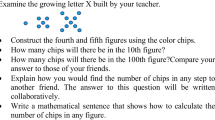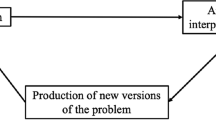Abstract
This article concerns student sense making in the context of algebraic activities. We present a case in which a pair of middle-school students attempts to make sense of a previously obtained by them position formula for a particular numerical sequence. The exploration of the sequence occurred in the context of two-month-long student research project. The data were collected from the students’ drafts, audiotaped meetings of the students with the teacher and a follow-up interview. The data analysis was aimed at identification and characterization of the algebraic activities in which the students were engaged and the processes involved in the students’ sense-making quest. We found that sense-making process consisted of a sequence of generational and transformational algebraic activities in the overarching context of a global, meta-level activity, long-term problem solving. In this sense-making process, the students: (1) formulated and justified claims; (2) made generalizations, (3) found the mechanisms behind the algebraic objects (i.e., answered why-questions); and (4) established coherence among the explored objects. The findings are summarized as a suggestion for a four component decomposition of algebraic sense making.





Similar content being viewed by others
Notes
The first author was the instructor and also the regular mathematics teacher for the class, in which the case of interest occurred.
The proofs are provided, for instance, in Golovina and Yaglom (1963).
References
Arcavi, A. (1994). Symbol sense: Informal sense-making in formal mathematics. For the Learning of Mathematics, 14(3), 24–35.
Arcavi, A. (2005). Developing and using symbol sense in mathematics. For the Learning of Mathematics, 25(2), 42–47.
Blumenfeld, P., Soloway, E., Marx, R., Krajcik, J., Guzial, M., & Palinscar, A. (1991). Motivating project-based learning: Sustaining the doing, supporting the learning. Educational Psychologist, 26, 369–398.
Graham, K., Cuoco, A., & Zimmermann, G. (2010). Focus in high school mathematics: Reasoning and sense making in algebra. Reston: National Council of Teachers of Mathematics.
Golovina, L. I. & Yaglom, I.M. (1963). Induction in Geometry. Boston: D. C. Heath.
Hewitt, D. (1992). Train spotters’ paradise. Mathematics Teaching, 140, 6–8.
Hoch, M., & Dreyfus, T. (2006). Structure sense versus manipulation skills: An unexpected result. In J. Novotná, H. Moraová, M. Krátká, & N. Stehlíková (Eds.), Proceedings of the 30th conference of the international group for the psychology of mathematics education (Vol. 3, pp. 305–312). Prague: Charles University.
Kieran, C. (1996). The changing face of school algebra. In C. Alsina, J. Alvarez, B. Hodgson, C. Laborde, & A. Pérez (Eds.), Eighth international congress on mathematical education: Selected lectures (pp. 271–290). Seville: S.A.E.M. Thales.
Kieran, C. (2007). Learning and teaching algebra at the middle school through college levels: Building meaning for symbols and their manipulation. In F. K. Lester (Ed.), Second handbook of research on mathematics teaching and learning (pp. 707–762). Charlotte: Information Age.
Lannin, J. K. (2005). Generalization and justification: The challenge of introducing algebraic reasoning through patterning activities. Mathematical Thinking and Learning, 7(3), 231–258.
Leikin, R., & Berman, A. (2016). Mathematics for students with high mathematical potential in Israel. In B. Vogeli (Ed.), Special secondary schools for the mathematically talented: An international panorama (pp. 117–144). New Jersey: World Scientific.
Mason, J. (1989). Mathematical abstraction as the result of a delicate shift of attention. For the Learning of Mathematics, 9(2), 2–8.
Mason, J., & Johnston-Wilder, S. (Eds.). (2004). Fundamental constructs in mathematics education. London: Routledge Falmer.
NCTM (National Council of Teachers of Mathematics). (2009). Executive summary: Focus in high school mathematics: Reasoning and sense-making. Reston: The Author.
Palatnik, A. (2016) Learning through long-term mathematical research projects (Unpublished doctoral dissertation). Technion – Israel Institute of Technology, Haifa, Israel.
Palatnik, A., & Koichu, B. (2014). Reconstruction of one mathematical invention: Focus on shifts of attention. In P. Liljedahl, C. Nicol, S. Oesterle, & D. Allan (Eds.), Proceedings of the 38th conference of the international group for the psychology of mathematics education (Vol. 3, pp. 377–384). Vancouver: PME.
Palatnik, A., & Koichu, B. (2015). Exploring insight: Focus on shifts of attention. For the Learning of Mathematics, 35(2), 9–14.
Pólya, G. (1954). Induction and analogy in mathematics. Princeton: Princeton University Press.
Radford, L. (2001). The historical origins of algebraic thinking. In R. Sutherland, T. Rojano, A. Bell, & R. Lins (Eds.), Perspectives on school algebra (pp. 13–36). Dordrecht: Kluwer.
Radford, L. (2004). Syntax and meaning. In M. J. Hoines & A. B. Fuglestad (Eds.), Proceedings of the 28th Conference of the International Group for the Psychology of Mathematics Education (Vol. 1, pp. 161–166). Bergen, Norway.
Radford, L. (2010). Layers of generality and types of generalization in pattern activities. PNA - Pensamiento Numérico Avanzado, 4(2), 37–62.
Rojano, T., Filloy, E., & Puig, L. (2014). Intertextuality and sense production in the learning of algebraic methods. Educational Studies in Mathematics, 87(3), 389–407.
Sandefur, J., Mason, J., Stylianides, G. J., & Watson, A. (2013). Generating and using examples in the proving process. Educational Studies in Mathematics, 83(3), 323–340.
Schoenfeld, A. H. (1992). Learning to think mathematically: Problem solving, metacognition, and sense-making in mathematics. In D. Grouws (Ed.), Handbook for research on mathematics teaching and learning (pp. 334–370). New York: Macmillan.
Schoenfeld, A. H. (2013). Reflections on problem solving theory and practice. The Mathematics Enthusiast, 10(1–2), 9–34.
Sfard, A. (2008). Thinking as communicating: Human development, the growth of discourses, and mathematizing. Cambridge: Cambridge University Press.
Smith, J. C. (2006). A sense-making approach to proof: Strategies of students in traditional and problem-based number theory courses. The Journal of Mathematical Behavior, 25(1), 73–90.
Tabach, M., Arcavi, A., & Hershkowitz, R. (2008). Transitions among different symbolic generalizations by algebra beginners in a computer intensive environment. Educational Studies in Mathematics, 69(1), 53–71.
Acknowledgements
This research was supported by Grant No. 1596/13 from the Israel Science Foundation. In addition, the first author wishes to express his gratitude to the Technion Graduate School and Mandel Leadership Institute. We also wish to thank the anonymous reviewers for their valuable suggestions on the previous versions of this article.
Author information
Authors and Affiliations
Corresponding author
Rights and permissions
About this article
Cite this article
Palatnik, A., Koichu, B. Sense making in the context of algebraic activities. Educ Stud Math 95, 245–262 (2017). https://doi.org/10.1007/s10649-016-9744-1
Published:
Issue Date:
DOI: https://doi.org/10.1007/s10649-016-9744-1




